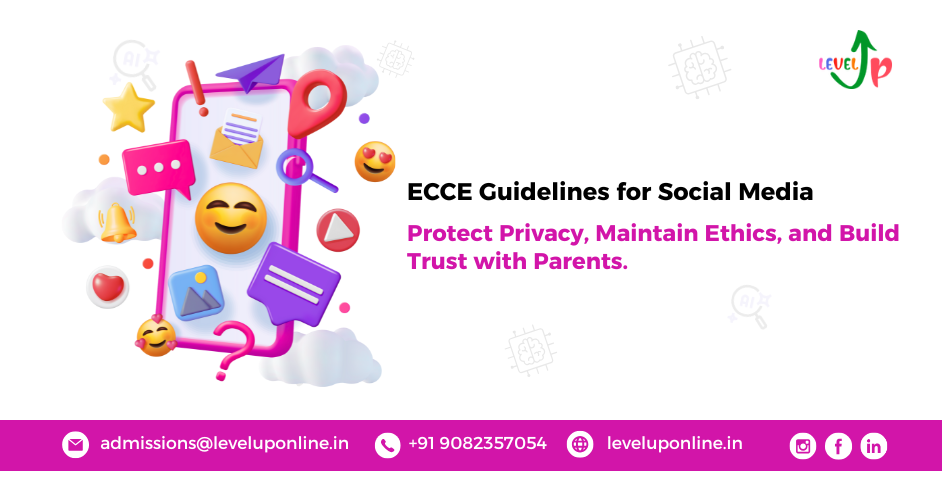Introduction
Celebrating a child’s creativity is a special part of ECCE (Early Childhood Care and Education). Teachers often want to showcase classroom projects, crafts, or drawings on social media or school websites to keep parents engaged. Parents, too, enjoy seeing their child’s progress online.
But here’s the question: How can educators share children’s work without compromising privacy and safety? This is where following the right ECCE guidelines becomes essential. In this blog, we’ll share five detailed strategies to help you share children’s work safely and responsibly.
Why ECCE Guidelines Matter for Online Sharing
Posting a picture of a child’s artwork may seem harmless, but small details—like a child’s name, school logo, or background setting—can unintentionally reveal personal information. Without the right precautions, these images can be misused or fall into the wrong hands. That’s why every ECCE educator should follow clear guidelines before sharing any student content online.
5 Detailed ECCE Guidelines to Share Children’s Work Safely
1. Always Obtain Written Parental Consent
Before posting any student work, written consent from parents is non-negotiable. This is the first and most important step in the ECCE guidelines because parents have the right to decide how their child’s images or work are used.
How to implement this:
i. Create a standard consent form that clearly states where and how children’s work will be shared (school website, social media, newsletters).
ii. Give parents the option to say yes or no to specific platforms.
iii. Renew consent forms annually or whenever there’s a policy change.
By getting documented permission, educators build trust and avoid legal or ethical issues later.
2. Remove All Personal Identifiers from Images
One of the most overlooked steps is removing any detail that identifies the child personally. According to ECCE guidelines, even small details like name tags, school badges, or location hints should be removed before sharing.
Practical tips:
i. Crop images to show only the artwork.
ii. Blur or cover name tags on desks, boards, or artwork.
iii. Avoid captions that mention full names—use first names or initials only.
This way, the focus stays on the work and not on the child’s identity.
3. Avoid Showing Faces or Use Creative Angles
Showing a child’s face online can lead to privacy risks. ECCE guidelines recommend avoiding face visibility whenever possible. Instead, focus on hands holding the art or a zoomed-in view of the craft.
Practical approach:
i. Capture only the work, with the child’s back to the camera.
ii. Use stickers or blur tools to cover faces if needed.
iii. If the post includes a group activity, take a wide shot where faces aren’t clearly visible.
These steps protect identity without losing the essence of the achievement.
4. Share Only on Secure and Private Platforms
Posting on public social media accounts exposes student work to unknown audiences, which can be risky. As per ECCE guidelines, teachers should always use restricted-access platforms where only parents and authorized staff can view the content.
Where to post safely:
i. Official school apps or portals.
ii. Private social media groups (closed groups with approval-based membership).
iii. Encrypted communication tools for sharing updates with parents.
This controlled approach minimizes exposure and keeps parents informed in a secure environment.
5. Add Watermarks and Copyright Notices
Even if your post is on a private group, screenshots can circulate. ECCE guidelines suggest adding a school watermark or copyright notice to prevent misuse.
How to do it:
i. Use the school’s name/logo as a watermark on images.
ii. Add a short disclaimer like “For parental viewing only” in the caption.
iii. Use low-resolution images for online sharing to reduce the risk of replication.
This ensures your content stays associated with your school and discourages unauthorized sharing.
Why Following ECCE Guidelines Protects Everyone
Ignoring these ECCE guidelines can lead to serious consequences:
✔ Breach of student privacy.
✔ Loss of parental trust.
✔ Legal issues under child protection policies.
✔ Damage to the school’s reputation.
By following these steps, teachers can celebrate students’ achievements online without risking safety or ethics.
FAQ: ECCE Guidelines for Sharing Children’s Work Online
Q1: Is parental consent always required in ECCE?
Yes, written parental consent is a must before sharing any child’s work online.
Q2: Can teachers share classroom photos on public social media?
No, as per ECCE guidelines, sharing on public platforms is not safe. Use private and secure channels only.
Q3: What is the safest way to share student work?
Post on closed groups or school platforms, avoid showing faces, and always add a watermark.
Final Thoughts
Sharing students’ creativity online can be positive—if it’s done with safety and ethics in mind. Following these ECCE guidelines ensures teachers celebrate achievements without risking privacy, building trust with parents and creating a secure digital environment for children.


